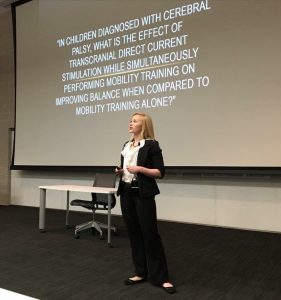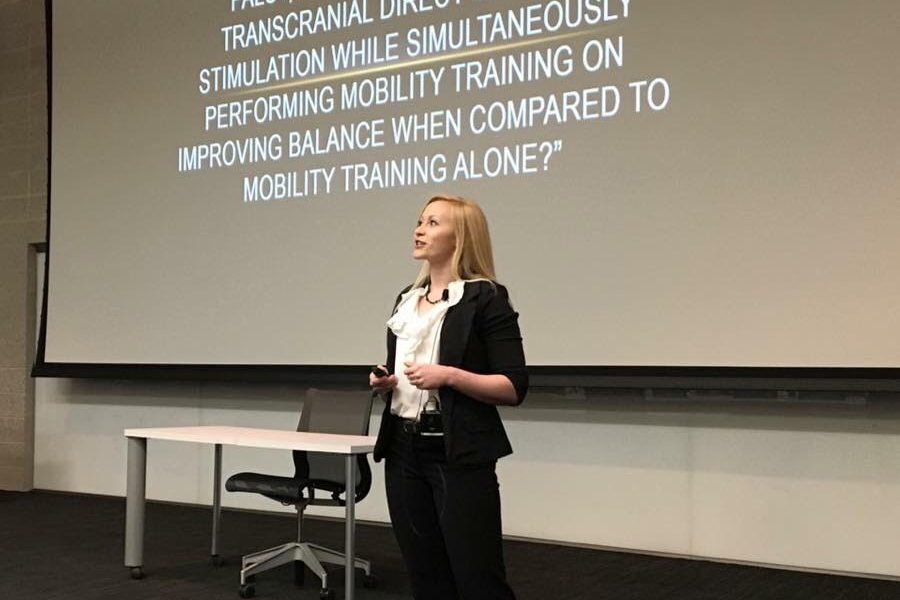Physical therapists utilize evidenced-based practice in order to inform their decision-making in the clinic. Instilling this practice into students, the NAU Physical Therapy Department has supplied physical therapy students with the necessary tools to be able to analyze, assess, and appraise the available literature in their field. Each year, second-year physical therapy students are asked to give a twelve-minute presentation to their peers and faculty, coined “PICO Presentations” for Population Intervention Comparison Outcome (PICO). Each student formulates a PICO question addressing the efficacy of a specific intervention in a given population and will then search numerous databases in order to find the best evidence that can answer that question. These presentations serve many purposes in the NAU physical therapy program. First, it provides students the opportunity to research something that interests them with an approach they may one day be interested in utilizing with their patients. Secondly, the chance to present in front of an audience is great practice for students who plan on presenting their own research at conferences. Thirdly, it allows fellow students and staff to become aware of and better understand a topic they may not have been previously familiar with. Finally, the PICO presentations give direction to the students presenting in order to prepare them to begin the capstone projects required to complete their doctoral program.
While best evidence is important for guiding clinical decision-making, there are several interventions in the field of physical therapy that have limited research available. Due to this lack of substantial evidence, it is pertinent to not only address the literature but also assess the opinions of clinical experts. When answering the given PICO question, students must not only guide their response based on the best evidence but must also consider the feedback from local clinicians who may use the intervention or pioneers in the implementation of certain practices. In order to gain this perspective, students reach out to different providers and are able to evaluate their insight on whether the intervention outcomes in a research setting matches the clinical application. This opens a dialogue not only about a chosen intervention but also about a specific interest that the student may share with a practicing clinician. It provides a wonderful opportunity to network with leading experts and clinicians whom students may one day be working beside.
At the heart of every intervention is the patient it is utilized for, which is why the patient’s perspective of an intervention is also taken into consideration when answering the proposed PICO question. While an intervention’s results may look good on paper, it may not be favored by patients, so understanding how a patient feels about a given intervention is useful when determining whether or not it should be used clinically. While patient’s feedback is subjective and may vary from person to person, understanding the patient’s opinion can help determine what drives an intervention’s success and the patient’s compliance to the program.
 Lastly, when evaluating a given intervention for a population, it is important to understand the value. Students presenting are asked to address the financial value for the patient and understand if the cost is appropriate to the benefit. Students are also asked to address the overall value for the clinician and whether offering this novel approach is worth the cost to attain the education or certification necessary in order to utilize it. Many of the questions students may address include: What continuing education or certifications are necessary to be able to use this intervention? How expensive will this intervention be to my patient? How expensive would it be to purchase this certain device in order to use the intervention clinically? Are the results worth the cost?
Lastly, when evaluating a given intervention for a population, it is important to understand the value. Students presenting are asked to address the financial value for the patient and understand if the cost is appropriate to the benefit. Students are also asked to address the overall value for the clinician and whether offering this novel approach is worth the cost to attain the education or certification necessary in order to utilize it. Many of the questions students may address include: What continuing education or certifications are necessary to be able to use this intervention? How expensive will this intervention be to my patient? How expensive would it be to purchase this certain device in order to use the intervention clinically? Are the results worth the cost?
Some interventions may provide great results but can require thousands of dollars’ worth of training and education, making them less appealing to the clinician. Other interventions have little to no cost but may not demonstrate a significant improvement for the patient, so it is up to the student to use their clinical judgement to decide the best intervention for a given patient based on its value.
PICO presentations are a way for students to begin applying evidence-based practice before they even begin working in their field. This preparation helps instill confidence in students’ ability to make decisions and educates them on the tools they can use to guide their own practice. Some of the topics addressed by students’ presentations this year include:
- Transcranial Direct Current Stimulation in Children with Cerebral Palsy
- Gait Step Training in Community-Dwelling Older Adults
- Tango Dance in Patient with Parkinson’s, Dual-Task Training in Patients with Stroke
- The Effects of Sleep in Patients with Traumatic Brain Injury
- Complete Decongestive Therapy in Patients with Breast Cancer-Related Lymphedema and the Use of Manipulation in Treating Cervicogenic Headaches.
Students have addressed topics relevant for physical therapy in pediatric, oncological, geriatric, orthopedic, neurological, and acute care settings, and have researched interventions that are still in the research phase and those that are already heavily utilized clinically. These PICO presentations have exposed students to novel approaches in a setting they are passionate about, helping them grow both personally and professionally.
Amanda Sweig is a part of the graduating class of December 2018 in the NAU Doctor of Physical Therapy program. She graduated from Barrett, the Honors College at ASU, in 2015 with a Bachelor of Science in kinesiology and a minor in dance. Amanda is interested in working with pediatric patients with developmental disabilities, utilizing an interdisciplinary team approach in order to provide holistic care. In her free time, Amanda loves to teach dance, run long distance, and travel.


